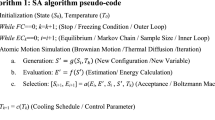Abstract
The purpose of this paper is to improve the simulated annealing method with a variable neighborhood search to solve the resource-constrained scheduling problem. We also compare numerically this method with other neighborhood search (local search) techniques: threshold accepting methods and tabu search. Furthermore, we combine these techniques with multistart diversification strategies and with the variable neighborhood search technique. A thorough numerical study is completed to set the parameters of the different methods and to compare the quality of the solutions that they generate. The numerical results indicate that the simulated annealing method improved with a variable neighborhood search technique is indeed the best solution method.
Similar content being viewed by others
References
Alcaraz, J., & Maroto, C. (2001). A robust algorithm for resource allocation in project scheduling. Annals of Operations Research, 102, 83–109.
Aubin, J., & Ferland, J. A. (1989). A large scale timetabling problem. Computers and Operations Research, 16, 67–77.
Baar, T., Brucker, P., & Knust, S. (1998). Tabu-search algorithms and lower bounds for the resource-constrained project scheduling problem. In S. Voss, S. Martello, I. Osman, & C. Roucairol (Eds.), Meta-heuristics: advances and trends in local search paradigms for optimization (pp. 1–18). Dordrecht: Kluwer Academic.
Baptiste, P., Le Pape, C., & Nuijten, W. (1999). Satisfiability and time-bound adjustments for cumulative scheduling problems. Annals of Operations Research, 92, 305–333.
Blazewicz, J. (1978). Complexity of computer scheduling algorithms under resources constraints. In Proceedings first meeting AFCET-SMF on applied mathematics (pp. 169–178), Palaiseau, Poland.
Bouffard, V. (2003). Méthodes heuristiques pour un problème d’ordonnancement avec contraintes sur les ressources. Master thesis, Département d’informatique et de recherche opérationnelle, Université de Montréal, Canada, April 2003.
Bouleimen, K., & Lecocq, H. (1998). A new efficient simulated annealing algorithm for the resource-constrained project scheduling problem. In G. Barbasoǧlu, S. Karabati, L. Ozdamar, & G. Ulusoy (Eds.), Proceedings of the sixth international workshop on project management and scheduling (pp. 19–22). Istanbul: Boǧaziçi University Pringing Office.
Brucker, P., & Knust, S. (2001). Resource-constrained project scheduling and timetabling. In E. Burke & W. Erben (Eds.), Lecture notes in computer science : Vol. 2079. PATAT III (pp. 277–293). Berlin: Springer.
Brucker, P., Drexl, A., Möhring, R., Neumann, K., & Pesch, E. (1999). Resource-constrained project scheduling: notation, classification, models, and methods. European Journal of Operational Research, 112, 3–41.
Burke, E. K., & Petrovic, S. (2002). Recent research directions in automated timetabling. European Journal of Operational Research, 140, 266–280.
Carlier, J., & Pinson, E. (1998). Jackson’s pseudo-preemptive schedule for the P m /r i ,q i /C max scheduling problem. Annals of Operations Research, 83, 41–58.
Cerny, V. (1985). Thermodynamical approach to the traveling salesman problem: an efficient simulation algorithm. Journal of Optimization Theory and Applications, 45, 41–51.
de Werra, D. (1985). An introduction to timetabling. European Journal of Operational Research, 19, 151–162.
Dueck, G. (1993). New optimization heuristics: the great deluge algorithm and the record-to-record travel. Journal of computational Physics, 104, 86–92.
Dueck, G., & Scheuer, T. (1990). Threshold accepting: a general purpose optimization algorithm appearing superior to simulated annealing. Journal of Computational Physics, 90, 161–175.
Ferland, J. A., Hertz, A., & Lavoie, A. (1996). An object-oriented methodology for solving assignment-type problems with neighborhood search techniques. Operations Research, 44, 347–359.
Glover, F. (1986). Future path for integer programming and links to artificial intelligence. Computers and Operations Research, 13, 533–549.
Hansen, P. (1986). The steepest ascent mildest descent heuristic for combinatorial programming. In: Congress on numerical methods in combinatorial optimization, Capri, Italy.
Hansen, P., & Mladonović, N. (2001). Variable neighborhood search: principles and applications. European Journal of Operations Research, 130, 449–467.
Hartmann, S. (1998). A competitive genetic algorithm for resource-constrained project scheduling. Naval Research Logistics, 45, 733–750.
Jeffcoat, D. E., & Bulfin, R. L. (1993). Simulated-annealing for resource-constrained scheduling. European Journal of Operational Research, 70, 43–51.
Kelly, J. P., Laguna, M., & Glover, F. (1994). A study of diversification strategies for the quadratic assignment problem. Computers and Operations Research, 21, 885–893.
Kirkpatric, S., Gelatt, C. D. Jr., & Vecchi, M. P. (1983). Optimization by simulated annealing. Science, 220, 671–680.
Kolisch, R., Sprecher, A., & Drexl, A. (1995). Characterization and generation of resource-constrained project scheduling problems. Management Science, 41, 1693–1703.
Mladenović, N., & Hansen, P. (1997). Variable neighborhood search. Computers and Operations Research, 24(11), 1097–1100.
Petrovic, S., & Burke, E. K. (2004). University timetabling. In J. Y. -T. Leung (Ed.), Handbook of scheduling: algorithms, models, and performance analysis. Boca Raton: CRC Press, Chap. 45.
Reeves, C. R. (1996). Modern heuristic techniques. In V. J. R. Smith, I. H. Osman, C. R. Reeves, & G. D. Smith (Eds.), Modern heuristic search methods (pp. 1–25). New York: Wiley.
Schaerf, A. (1999a). A survey of automated timetabling. Artificial Intelligence Review, 13, 87–127.
Schaerf, A. (1999b). Local search techniques for large high school timetabling problems. IEEE Transactions on Systems, Man and Cybernetics, Part A, 29, 368–377.
Schaerf, A. (2006). Measurability and reproducibility in timetabling. In E. K. Burke & H. Rudova (Eds.), Proceedings of the 6th international conference on the practice and theory of automated timebabling (pp. 53–62). Brno: Masaryk University.
Srivastav, A., & Stangier, P. (1997). Tight approximations for resource constrained scheduling and bin packing. Discrete Applied Mathematics, 79, 223–245.
Taillard, E. (1991). Robust tabu search for the quadratic assignment problem. Parallel Computing, 17, 443–455.
Van Laarhoven, P. J. M., Aarts, E. H. L., & Lenstra, J. K. (1992). Job shop scheduling by simulated annealing. Operations Research, 40, 113–125.
Zhang, G., Cai, X., & Wong, C. K. (2004). Some results on resource constrained scheduling. IIE Transactions, 36, 1–9.
Author information
Authors and Affiliations
Corresponding author
Additional information
This research was supported by NSERC grant (OGP 0008312) the first author received a FCAR fellowship during her M.Sc. studies.
Rights and permissions
About this article
Cite this article
Bouffard, V., Ferland, J.A. Improving simulated annealing with variable neighborhood search to solve the resource-constrained scheduling problem. J Sched 10, 375–386 (2007). https://doi.org/10.1007/s10951-007-0043-7
Published:
Issue Date:
DOI: https://doi.org/10.1007/s10951-007-0043-7




